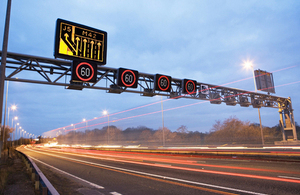CLEAR benefits for emergency services
The Highways Agency is re-opening lanes and carriageways more quickly following motorway incidents thanks to close collaboration with ambulance, fire and police crews.

The Agency is attending the Emergency Services Show to encourage more emergency responders to adopt the CLEAR protocol. CLEAR was introduced in 2011 to help the Highways Agency minimise the economic impact of road incidents and cut the resulting disruption to road users – and the Agency is working to make sure it is embedded in all emergency service response procedures.
Highways Agency Director of Customer Operations Simon Sheldon-Wilson said:
When incidents occur, our main priority is to safely clear the road and reopen it quickly. Any unnecessary delays in re-opening roads causes congestion for customers using our network, disrupts communities, and costs the economy tens of thousands of pounds.
For the emergency services, the focus is on rescuing and treating casualties, tackling fires or investigating the cause of the incident.
Therefore it’s essential we work effectively with fire, police and ambulance crews, so everyone can do their job properly during a high-pressure incident on the motorway.
Just one incident can force the closure of a three-lane motorway for several hours at a cost millions of pounds in lost time. About 77,000 incidents impact at least one motorway lane each year.
Since the launch of CLEAR, the Highways Agency has introduced several measures to speed up traffic incident management and keep vehicles moving after road incidents.
These include incident screens, which prevent congestion from rubbernecking by ‘hiding’ the scene of an incident; load cells, which allow traffic officers to legally and safely clear larger vehicles from live carriageways; spill kits for dealing with petrol and diesel on the road surface; and response vehicle safety and visibility improvements, such as alternating flashing headlamps and bullhorns. Most notable for the emergency services is investment in 38 laser scanners, which allows police investigators to capture evidence – and so re-open roads – more quickly at incident scenes.
Further improvements being investigated include measures to right and clear overturned vehicles, special lighting for incident scenes, and the implementation of CCTV in traffic officer vehicles.
Simon Sheldon-Wilson said:
We’re working to better understand what we can do to prevent incidents occurring in the first place. For example, we’re trialling a fully-equipped HGV tractor unit, which is loaned to police forces to aid the identification of driving offences.
We’ve introduced ways to improve incident management, which help us quickly clear roads and get vehicles moving again.
These vital improvements improve conditions for road users, while simultaneously safeguarding our staff, emergency services and other responders.
Incidents where emergency crews follow the CLEAR protocol are dealt with more quickly – and that’s why we’re encouraging more emergency responders to embed the protocol in their practises.
The Agency is hosting a seminar at the Emergency Services Show on 24 September, along with the police, to showcase CLEAR. It is also sponsoring a special workshop in early October, organised by the National Ambulance Resilience Unit.
The event will bring together representatives from the Ambulance Services, Highways Agency, Association of Chief Police Officers, and Chief Fire Officers Association to discuss CLEAR.
It will also allow the Highways Agency to explain how smart motorways work and discuss the implications for responding agencies. Smart motorways ease congestion either by making the hard shoulder available as an extra lane at times of peak demand or by permanently converting the hard shoulder to a running lane. The approach has already proved successful, but requires changes to the way that emergency services respond to incidents due to the lack of hard shoulder.
Simon Sheldon-Wilson said:
We’re investing in smart motorways, as they’re a big improvement for road users, and cut congestion during peak periods.
As they are live carriageways, they pose a challenge for emergency responders – who cannot rely on an empty hard shoulder to access the scene.
By working closely with the emergency services, we can ensure everyone stays safe when responding to an incident.
We’re committed to improving safety after incidents, while speeding up our actions to clear and reopen lanes more quickly to ease congestion. The relationship with our emergency services partners plays a key role in helping us to achieve this.
The Emergency Services Show takes place at the Birmingham NEC on 24 and 25 September.
The CLEAR / smart motorways workshop will take place in Birmingham on 6 October.
General enquiries
Members of the public should contact the Highways Agency Information Line on 0300 123 5000.
Media enquiries
Journalists should contact the Highways Agency press office on 0844 693 1448 and use the menu to speak to the most appropriate press officer.